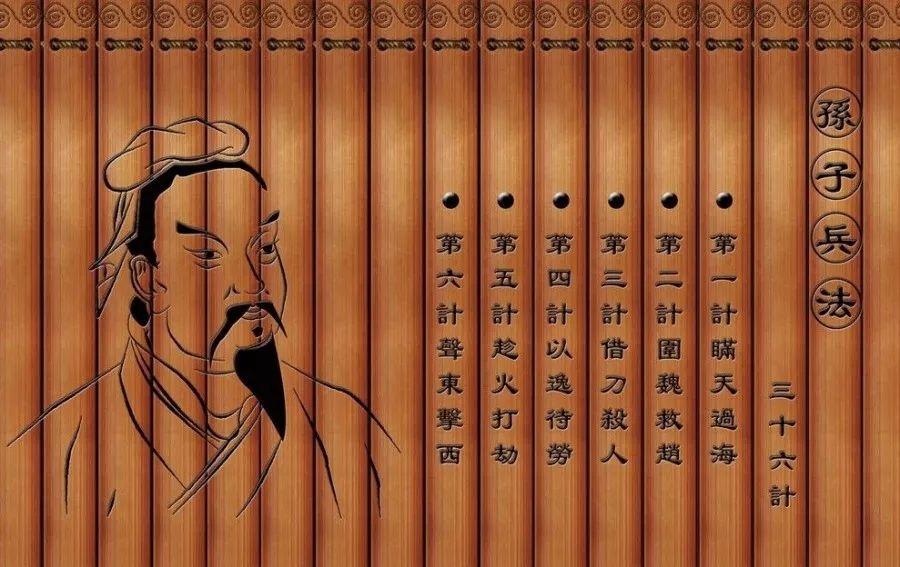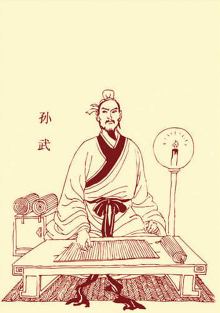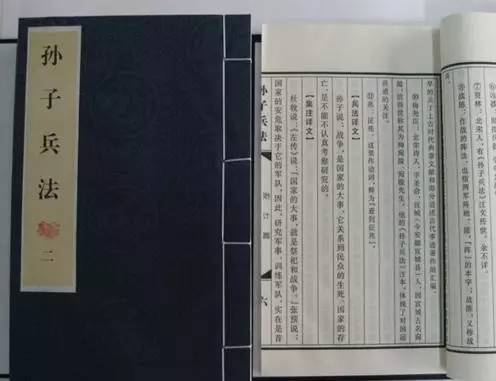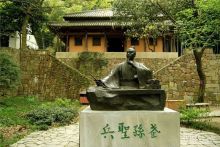I. The people-oriented thought of “Tao” first
Sun Tzu’s “The Art of War” begins with the following statement: “The military is the great matter of the state, the place of death and life, the way of survival, and must not be ignored.” Because of the pivotal position of the military, “Therefore, the five matters were studied, and the plan was studied, and the situation was studied.” Sun Tzu used the “Five Matters” as a standard to measure the strength of both sides in battle, to analyze and compare the strength of the enemy and us, and to predict the possibility of victory. Sun Tzu believed that among the “Five Things”, the “Way” was the first, and the “Way” was the direction of the people’s hearts, reflecting Sun Tzu’s simple people-oriented thinking. Sun Tzu’s simple people-oriented thinking is expressed in the following three aspects:
(1) The idea of prudent warfare for the protection of the people
“Sun Tzu’s people-oriented thinking is reflected in his profound understanding of the disasters that war brings to the country and its people, and his prudent attitude toward war and the purpose of war to protect the country and its people. Sun Tzu believed that “war is a great matter for the state, a place of death and life, and a way to survive and perish. The ruler was required to take a prudent approach to war as a national event. The reason is that “there is no such thing as a long-lasting army that benefits the state.” And especially pointed out that “the Lord can not be angry and raise the division, the general can not huff and puff to war. This is the way to secure the whole army.” Sun Tzu believed that the purpose of war is not to conquer cities and plunder wealth, but to “secure the state and the whole army”, so he made whether it is in the interest of the state and the people the fundamental criterion for waging war, and asked generals to abide by the principle of “being a protector of the people, and the interests of the Lord”. The principle In addition, in order to minimize the loss of war, Sun Tzu advocated the use of strategy and friendship to win the war, rather than conquest by force, so as to achieve the highest level of “not to blunt the army but to make the advantage complete”. The highest level is achieved.
The highest level of victory is achieved by “not blunting the army, but making the best of it.
Sun Tzu’s Art of War
(2) Valuing the power of the people
Sun Tzu regarded “the Way” as the primary weapon to overcome the enemy and win, and believed that “the Way is to make the people agree with the top, so that they can die with it and live with it without being tricky.” He recognized that people’s support and advocacy is the key to victory in war, as the saying goes, “The one who wants the same thing from the top and the bottom wins. As Chen Ying said, “Sun Tzu’s “Art of War” firstly clarifies that political factors, moral orientation and public sentiment play a decisive role in the success or failure of war. Therefore, in Sun Tzu’s view, the reason for waging war is to respect the interests and wishes of the people is that victory can only be achieved with the widespread support and participation of the people.
(3) The Humane Idea of Caring for Soldiers
Sun Tzu’s ideal of the highest level of warfare – “giving up the army without fighting” – is the highest expression of his idea of “benevolent warfare”. He believed: “The whole army is the best, the broken army is the second best; the whole soldier is the best, the broken soldier is the second best. It is not the best of the good to win a hundred battles; it is the best of the good to yield to the enemy without fighting.” From this, it can be seen that Sun Tzu opposed the bloody war and pursued the ultimate goal of minimizing the sacrifice of war and achieving “peace for the whole army”. On this basis, Sun Tzu specifically put forward the humanitarian idea that generals should “love their soldiers as their sons” and “treat their soldiers as if they loved their sons, so they could die with them.” In addition, Sun Tzu dialectically argued that “benevolence” is not “coddling”, but “coddling” will give birth to “pride”. The soldiers of “pride” should not be used in war, because pride will be defeated and die easily in battle, which is also not the way to love soldiers. Finally, Sun Wu also extends himself to others, “the rook is mixed and multiplied, the pawn is good and raised.” He advocated that generals should love their own soldiers as well as treat the enemy’s people well, and should not abuse and kill surrendered soldiers.
In short, Sun Tzu’s approach to war always revolves around the people-oriented idea of “humanitarianism,” which advocates waging war carefully, minimizing the sacrifice of war, loving soldiers, treating prisoners well, and valuing the power of the people. This is a simple and intuitive principle of historical materialism. Although Sun Tzu waged war with the ultimate aim of safeguarding the interests of the ruling class rather than safeguarding the interests of the people, and the utilitarian class, narrow-mindedness, limitations and selfishness still existed in his view of war, this was mainly limited by the time and class in which he lived, and could not conceal the advanced nature of the people-oriented thinking in The Art of War in that era.

Sun Wu
II. The Ideology of Plain Dialectics
(I) Connection
Although Sun Tzu’s The Art of War is a book of warfare, it never places the military in isolation, but uses the idea that the connection between things is universal, linking the conditions of multiple factors to contribute to the victory of war. At the beginning of the book, Sun Tzu identifies five factors on which victory in war depends: “Tao” (the way), “Heaven” (the weather and seasons), “Earth” (the topography and terrain), and “General” (the commander). The “general” is the commanding ability, and the “law” is the military rules and discipline. Sun Tzu even noticed that every grass and tree could be related to the battle: “When the trees move, they come; when the grass is full of obstacles, they are suspicious; when the birds rise, they are ambushed; when the beasts are frightened, they are overwhelmed”. In addition, “The Art of War” also recognizes that military victory cannot be achieved without political and economic support. Economically, “the method of using the army is to use a thousand carts, a thousand leather carts, a hundred thousand armor, a thousand miles of food; the cost of internal and external, the cost of guests, the material of glue and paint, the cost of carriage and armor, the daily cost of a thousand gold.” Politically, “the way of a king is to love his people”, emphasizing that a just war is what the people want, so that the people will support and embrace it. This shows that Sun Tzu already had a deep understanding of the relationship between war and economics and politics. In addition to understanding the situation on our side, Sun Tzu also advocated that “if you know your enemy and know yourself, you will never be in danger in a hundred battles”, and that only by considering the military situation of both the enemy and ourselves can you make an effective battle plan.
(2) Development
Sun Tzu said in the chapter of “The Situation”: “Infinity is like heaven and earth, inexhaustible like the river and the sea”, which shows that Sun Tzu has fully realized that all things are in the process of movement and development. He looked at the military with a developmental perspective and proposed that “there is no constant situation in the army and no constant shape in the water. The one who can win because of changes in the enemy is called a god. This shows that Sun Tzu has realized that the situation of war is changing rapidly, and that there is no fixed way for the army to fight, and that only by adapting to the changes of the enemy can it be invincible. Therefore, he said, “If you know how to use the army, you will know how to use the army; if you don’t know how to use the army, you will know the terrain, but you can’t get the advantage of the land; if you don’t know how to use the army, you will know the five advantages, but you can’t get the advantage of the people”, and he also said, “Follow the enemy by practicing ink to decide the battle. In the implementation of the battle plan, according to the changes in the enemy’s situation to be flexible and mobile, in order not to be constrained by the enemy. Only by constantly adjusting one’s combat style and strategic tactics can one promote war in a favorable direction. In order to achieve this, Sun Tzu proposed the idea of “the general is capable but the army is not imperial” and “the general is not subject to the orders of the king”, which requires that the general be given sufficient decision-making power to ensure that strategic and tactical adjustments can be made in a timely manner in response to the rapidly changing situation on the battlefield.
(3) Contradiction
Laozi pointed out in the Tao Te Ching: “The length of the short, the difficulty of the easy, the front and back, the high and the low.” This embodies the view that contradiction is the unity of opposites. Sun Tzu inherited this view and applied it innovatively to the military field, which became an important method for dealing with military problems. Sun Tzu pointed out, “Therefore, a wise man’s consideration must be mixed with profit and harm. Mixed with the benefits and the services are credible, mixed with the hazards and the problems can be solved.” He soberly saw that profit and harm can exist in a unity of opposites, and there is no absolute profit and harm, as long as the appropriate method is applied, the transformation from harm to profit can be realized. Thus he pointed out, “Chaos is born from governance, timidity from courage, and weakness from strength.” He recognized that rule and chaos, courage and cowardice, strength and weakness were originally opposites, but they were also contradictory phenomena that were born together and transformed into each other, so he proposed the strategy and tactics of “the enemy is able to work when he is free, hungry when he is full, and active when he is safe”.
In addition, Sun Tzu considered the diversity of contradictions and proposed the methodology of specific analysis of specific problems. For example, according to the different strengths of the enemy and us, he specifically pointed out, “Therefore, the method of using the army, ten is to surround, five is to attack, twice is to divide, the enemy is able to fight, less is able to escape, not if it is able to avoid.”
The Art of War shines with the light of ancient Chinese philosophical dialectic thought, but it is not just a simple continuation of the dialectic thought in the Tao Te Ching, but focuses more on how to bring into play the subjective initiative of man in order to make war develop in a favorable direction, i.e. “victory can be achieved”, and should follow The Art of War focuses more on how to bring into play human initiative in order to make war develop in the desired direction, i.e., “victory is possible”, and one should follow objective laws while actively exerting human initiative in order to make war develop in the desired direction.

Sun Tzu’s Art of War
Third, the idea of temple calculation
The temple calculation advocated by Sun Tzu is characterized by three main features: foreknowledge, comprehensiveness and depth:
(I) Foreknowledge
The foreknowledge of the temple calculation in The Art of War is mainly expressed in the estimation of the war situation and the choice of strategy and tactics before the battle. Sun Tzu believed that before the battle, one should analyze the basic situation of both sides and the direction of the war, so as to make a suitable battle plan and choose strategies and tactics to predict the victory or defeat of the war. Thus he said, “Therefore, if you know the place of war and the day of war, you can meet a thousand miles and fight; if you do not know the place of war and the day of war, then the left cannot save the right, the right cannot save the left, the front cannot save the back, and the back cannot save the front.” “Who will do the decree? What is the strength of the army? Who will train the soldiers? What are the rewards and punishments? This is how I know victory and defeat”. “Knowing” is a prerequisite for warfare. Only by mastering the basic situation of the enemy and us, the basic situation of war, can we choose the appropriate tactics and correctly estimate the victory or defeat of war. Therefore, Sun Tzu said in the “Women’s Platform Plan”: “not a war and the temple calculation of the winner, to calculate more; not a war and the temple calculation does not win, to calculate less, more calculations win less calculations, not to mention the no calculation? I view it in this way, victory and defeat is seen.” Sun Tzu believed that with the knowledge of the enemy and us, the temple calculation could predict the victory and defeat of the war, and then decide whether to start the war or make a suitable battle plan.
(2) Comprehensiveness
According to Sun Tzu, the outcome of a war is subject to both objective conditions and human initiative, and the combination of the two constitutes the main content of the temple calculation. In “The Book of Planning”, Sun Tzu believes that the objective factor is the “five things and seven plans”, and the subjective factor is the “tricky way”. Only the organic combination of the two in the temple calculation can enable the general to make a correct judgment of the war situation and provide practical strategies and tactics. The “Five Things” are “Tao, Heaven, Earth, General, and Law”, which Sun Tzu regarded as the five objective factors for the general to predict the war situation, and Sun Tzu further elaborated them as “Seven Schemes”, namely Sun Tzu further elaborated them as “Seven Strategies”, namely: who has the right way, who has the right ability, who has the right heaven and earth, who has the right army, who has the right training, who has the right decree, and who has the right reward and punishment. The five things and seven plans are the objective factors before the battle, through the objective factors, the strength of the enemy and us can be estimated, which is the first step of the temple calculation. Next, the human subjective factors become the most critical step of the temple calculation. Sun Tzu cloud: “the calculation of interest to hear, is the potential to support its outside. Potential, because of the interest and control of power.” According to Sun Tzu, the five things and seven plans are not set in stone; as long as the general can adopt the right strategy and tactics, he can guide the war in a favorable direction. Therefore, in the temple calculation, the human subjective factor is crucial. Sun Bin’s Art of War – The Guest Master’s Score says: “The multitude wins? Then the battle will be fought by casting calculations. The rich wins? The one who measures the corn and fights. The one who has a strong armor wins? Then the victory is easy to know. Therefore, rich, not yet living in peace, poor, not yet living in danger, many, not yet living in victory, less, not yet living in defeat. Therefore, so the decision of victory and defeat of security and danger, the road.” This passage fully illustrates that the objective conditions before the battle cannot completely influence the victory or defeat of the war, but the general can give full play to his subjective initiative to change the difference in strength between the two sides and create favorable conditions for our victory. Therefore, Sun Tzu believes that a close combination of subjectivity and objectivity is necessary to accurately estimate the battlefield situation.
(III) Depth
Sun Tzu said, “The art of war is also a tricky way”. On the one hand, both sides of the war, in order to deceive the enemy, always hide the truth and show the falsehood, which requires the temple calculator to pay attention to the depth of the temple calculation, to see through the phenomenon to the essence, to discover the inevitable through chance, in the words of Sun Tzu, “to study the scheme and to explore its situation”. Therefore, the temple calculator should eliminate all kinds of interference, identify all kinds of illusions, quickly recognize the essence of things, and grasp the enemy’s true motives and purposes. On the other hand, Sun Tzu’s idea of “know your enemy and know yourself” requires us not only to know the enemy, but also to know the enemy’s “knowledge”, on the one hand, to understand the enemy’s situation, and on the other hand, to grasp the extent of the enemy’s knowledge of our situation. Only by knowing the enemy’s situation and the extent of their knowledge of us can we better determine the purpose of the enemy’s behavior and their next move, thus making ourselves invincible.
Sun Tzu’s idea of temple calculation is a collection of the strategic and tactical wisdom and experience of previous generations and the military of the time, and elevates it from experience to the level of theory, making the decision-making process more rational and systematic. Its foresight, comprehensiveness, and depth not only provided theoretical support for the decision makers of the time, but also provided a way of thinking and solutions for the practitioners of later generations.

Sun Wu Statue
IV. Conclusion
Sun Tzu’s “The Art of War” is an all-embracing, profound and thorough book with in-depth theories, especially because it is not limited to the art of war, but the ideas revealed in it are a concentrated reflection of the wisdom of our ancient sages. Although Sun Tzu was limited by his time and class and maintained the utilitarian view of war of the feudal exploiting class, and the philosophical thinking contained therein had not yet formed a system and remained at a simple and unconscious stage, The Art of War was still revered for its unique charm of military philosophy and the light of strategic wisdom. The people-oriented thinking, dialectical thinking and temple calculation ideas reflected in it are still respected and studied by later generations of militarists and politicians.